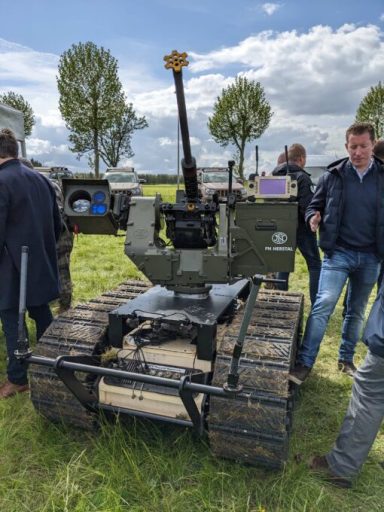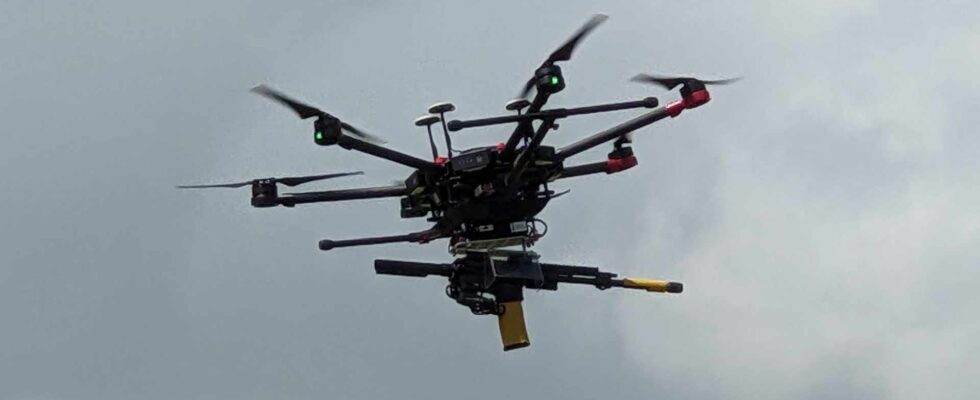The Army organized a day of presentation and demonstration of drones. While more and more armies are equipping themselves with drones, France could soon deploy its own on the ground.
Above us, the typical hum of a drone is heard. The small black craft rises above the field, propelled by its four motors, and begins its mission. It is not a classic drone, intended to take photos. This military drone is there for a specific purpose: to help soldiers identify enemy positions, allow them to better manage the situation and avoid unpleasant surprises.
A few minutes later, a second tracking drone was launched, much smaller and more discreet. Then comes the turn of a completely different kind of flying machine: huge, equipped with a gun. A flying weapon of war, which may soon be used by the French armed forces. Above us, the drone moves, rifle visible, and takes aim at an enemy that appeared at the end of the field.
We are not in a real war zone. We are on a military base in Yvelines, and we are attending an exercise, organized by the army as part of the 2nd edition of the CoHoMa challenge, to present its drones and show their potential in the field. The enemies are fake, and the wounded are just dummies. But drones are real. They could soon be sent to the front with the soldiers.
Drones to equip the French forces
Drones are a major evolution in army equipment. According to Pierre Schill, the Army Chief of Staff, present on the military base for the demonstration with the drones, it is even a ” turning point that should not be missed “. Since 2021 and the launch of the Vulcain project, of which the CoHoMa challenge is part, and which aims to integrate robots and artificial intelligence into the army ” by 2040 a lot of progress has been made. The objective of the day of May 10 was to show them, with a concrete application.
The exercise we are witnessing is simple: on a front line, enemy soldiers are trying to take up position in two different places. These positions would give them an advantage, and they should not be able to establish themselves there. A unit of soldiers is sent to dislodge them, and to do this, it is accompanied by several drones.

The first two to take off are scouting drones, which fly over the area and allow ground troops to better understand the terrain, the positions of adversaries, and plan an opening route. In this mission, we find a drone designed for military purposes by the French brand Parrot, very similar to tourist drones found on the market, and a Black Hornet nano-drone.
The latter, small, is particularly effective for missions requiring discretion, we are told. Indeed: while the Parrot drone emits this very recognizable noise, which makes it easily spotted by enemies, Black Hornet blends into the background. Inaudible, he is almost invisible a few meters away and the spectators who watch the exercise quickly lose track of him.
After the scouting phase comes the attack phase, and other drones come into play. After the armed flying drone, it is the turn of a remotely operated ground vehicle to arrive on the ground. Imposing, the drone is mounted on huge tracks, and it is equipped with an impressive gun, reminiscent of a kind of mini tank. We see him arrive on the field, and on the orders of the unit leader, shoot. The noise is deafening: you can see from afar the empty cartridges falling near the robot. Shortly after, another vehicle arrives. A sort of remote control stretcher, the platform is equipped with a kind of bed and allows the injured to be evacuated.

But the highlight of the show is undoubtedly the latest flying machines to appear. While the vehicle has already been firing for several minutes, a bomber drone arrives. Massive, but silent, we can see it moving above our heads. He carries around a dozen active grenade charges with him, and can do so for several kilometres. When the drone launches its first charge on an enemy position, the detonation is followed by a large cloud of white smoke.
Last demonstration, that of the remotely operated load – or suicide drone according to the more popular term – a novelty in France. Small, fairly discreet and light, the device aims to be as invisible as possible, and it is very difficult to see it from a distance during the test. Yet it is a drone with destructive potential, whose charge is equivalent to the power of two grenades. The particularity of this drone is that it is single-use: once the target has been spotted thanks to the on-board camera, the drone crashes against it, and activates the charge. The example we see during the simulation is not quite exactly like what happens in the field: it is a fake charge that has detonated, and the drone is recovered, although a little messed up. A thick black smoke still emerges from the place where the impact took place, further in the field.
After a final verification carried out on the ground by a rolling drone equipped with cameras, the simulation stops. The drone-assisted unit was able to carry out its mission, and prevented the enemies from taking the position.
What future for these drones?
Since 2021 and the start of the Vulcain project, a lot of progress has been made, particularly in terms of diversifying the sizes and uses of robots. They now make it possible to neutralize explosives, to explore buildings, and to assist in demining operations.
But the work is not finished: many improvements still need to be integrated. The army cites as objectives a ” scaling up to a robot combat teammate, with trusted artificial intelligence, cooperating and fully integrated into collaborative combat. It would also be necessary to increase the size of the robots to help the infantry, and to add decision-making autonomy.

For Pierre Schill, the Chief of Staff of the Army, “it is clear that the autonomy of robots is essential. A robot that would simply be remote-controlled would be of very limited interest”. The challenge now is to integrate artificial intelligence, he explains, which would allow the machines to gain autonomy in certain decisions and in certain modes of action. However, with a clear limit: Does this mode of action and this autonomy [doivent] go as far as the ability to kill, to destroy? In France, the position is: no. As soon as we are in an action that would be lethal, there must be a man in the loop. »
A limit that is not shared. ” It is clear that a certain number of other actors, in particular state actors, will probably be ready to have automatisms which go so far as to trigger lethal actions, without necessarily there being another human in the loop. “, he acknowledged. As a thinly veiled reference to the war between Russia and Ukraine.
For now, however, these drones are not in the field, and there is no specific date for their arrival yet. But that could soon change, and drones could be on the battlefield.” at very short notice “, according to the chief of staff of the army. The 2024 – 2030 military programming law, which must be examined in Parliament, plans to have “ the first operational capabilities, that is to say systems capable of accompanying troops in combat, and here I am talking about ground robot units, before 2030 », indicates Pierre Schill. Robots will soon be in the field.
Subscribe for free to Artificials, our AI newsletter, designed by AIs, verified by Numerama!
